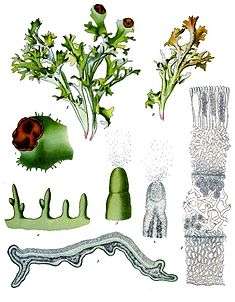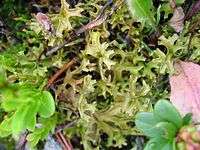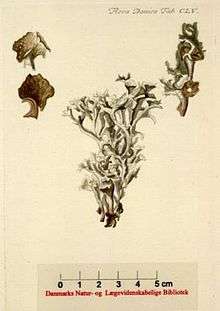Iceland moss
| Iceland moss | |
|---|---|
 | |
| Scientific classification | |
| Kingdom: | Fungi |
| Division: | Ascomycota |
| Class: | Lecanoromycetes |
| Order: | Lecanorales |
| Family: | Parmeliaceae |
| Genus: | Cetraria |
| Species: | C. islandica |
| Binomial name | |
| Cetraria islandica (L.) Ach. | |
Iceland moss (Cetraria islandica) is a lichen whose erect or upright, leaflike habit gives it the appearance of a moss, where its name likely comes from.
Description
It is often of a pale chestnut color, but varies considerably, being sometimes almost entirely greyish-white; and grows to a height of from 3 to 4 in., the branches being channelled or rolled into tubes, which end in flattened lobes with fringed edges.[1]

Range
It grows abundantly in the mountainous regions of northern countries, and it is specially characteristic of the lava slopes and plains of the west and north of Iceland. It is found on the mountains of north Wales, northern England, Scotland and south-west Ireland. In North America its range extends through Arctic regions, from Alaska to Newfoundland, and south in the Rocky Mountains to Colorado, and to the Appalachian Mountains of New England.[1]
Composition
In commerce it is a light-grey harsh cartilaginous body, almost colorless, and tastes slightly bitter. It contains about 70% of lichenin or lichen-starch, a body isomeric with common starch, but without structure. It also yields a peculiar modification of chlorophyll (called thallochlor), fumaric acid, lichenostearic acid, and cetraric acid (which gives it the bitter taste). It forms a nutritious and easily digested amylaceous food, being used in place of starch in some preparations of cocoa. It also contains lichesterinic acid and protolichesterinic acids.[1]
Uses
It is not, however, in great demand, and even in Iceland it is only occasionally used to make folk medicines,[2] and in a few traditional dishes. In earlier times, it was much more widely used in breads, porridges, soups etc.[3] Cetraric acid or cetrarin, a white micro-crystalline powder with a bitter taste, is readily soluble in alcohol, and slightly soluble in water and ether.[1] It has been recommended for medicinal use, in doses of 2 to 4 grains (0.1 to 0.25 grams), as a bitter tonic and aperient.[1] It is traditionally used to relieve chest ailments.[4]
Gallery
 Engraving of Cetraria islandica - Islandslav.jpga from the 18th century botanical work Flora Danica
Engraving of Cetraria islandica - Islandslav.jpga from the 18th century botanical work Flora Danica Cetraria islandica, Sarntaler Alpen, Italy
Cetraria islandica, Sarntaler Alpen, Italy Cetraria islandica, Zillertaler Alpen, Italy
Cetraria islandica, Zillertaler Alpen, Italy Cetraria islandica growing in a mat, Uppland, Sweden
Cetraria islandica growing in a mat, Uppland, Sweden
References
- 1 2 3 4 5 1911 Encyclopædia Britannica
- ↑ Cetraria islandica at Plants for the Future
- ↑ Iceland Recipe
- ↑ Iceland Moss
-
 This article incorporates text from a publication now in the public domain: Chisholm, Hugh, ed. (1911). "Iceland Moss". Encyclopædia Britannica (11th ed.). Cambridge University Press.
This article incorporates text from a publication now in the public domain: Chisholm, Hugh, ed. (1911). "Iceland Moss". Encyclopædia Britannica (11th ed.). Cambridge University Press.
External links
| Wikimedia Commons has media related to Cetraria islandica. |